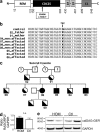Human CalDAG-GEFI gene (RASGRP2) mutation affects platelet function and causes severe bleeding
- PMID: 24958846
- PMCID: PMC4076591
- DOI: 10.1084/jem.20130477
Human CalDAG-GEFI gene (RASGRP2) mutation affects platelet function and causes severe bleeding
Abstract
The nature of an inherited platelet disorder was investigated in three siblings affected by severe bleeding. Using whole-exome sequencing, we identified the culprit mutation (cG742T) in the RAS guanyl-releasing protein-2 (RASGRP2) gene coding for calcium- and DAG-regulated guanine exchange factor-1 (CalDAG-GEFI). Platelets from individuals carrying the mutation present a reduced ability to activate Rap1 and to perform proper αIIbβ3 integrin inside-out signaling. Expression of CalDAG-GEFI mutant in HEK293T cells abolished Rap1 activation upon stimulation. Nevertheless, the PKC- and ADP-dependent pathways allow residual platelet activation in the absence of functional CalDAG-GEFI. The mutation impairs the platelet's ability to form thrombi under flow and spread normally as a consequence of reduced Rac1 GTP-binding. Functional deficiencies were confined to platelets and megakaryocytes with no leukocyte alteration. This contrasts with the phenotype seen in type III leukocyte adhesion deficiency caused by the absence of kindlin-3. Heterozygous did not suffer from bleeding and have normal platelet aggregation; however, their platelets mimicked homozygous ones by failing to undergo normal adhesion under flow and spreading. Rescue experiments on cultured patient megakaryocytes corrected the functional deficiency after transfection with wild-type RASGRP2. Remarkably, the presence of a single normal allele is sufficient to prevent bleeding, making CalDAG-GEFI a novel and potentially safe therapeutic target to prevent thrombosis.
© 2014 Canault et al.
Figures







Comment in
-
Identification of a severe bleeding disorder in humans caused by a mutation in CalDAG-GEFI.J Exp Med. 2014 Jun 30;211(7):1271. doi: 10.1084/jem.2117insight1. J Exp Med. 2014. PMID: 24980744 Free PMC article. No abstract available.
Similar articles
-
Novel mutations in RASGRP2, which encodes CalDAG-GEFI, abrogate Rap1 activation, causing platelet dysfunction.Blood. 2016 Sep 1;128(9):1282-9. doi: 10.1182/blood-2015-11-683102. Epub 2016 May 27. Blood. 2016. PMID: 27235135 Free PMC article. Clinical Trial.
-
Human CalDAG-GEFI deficiency increases bleeding and delays αIIbβ3 activation.Blood. 2016 Dec 8;128(23):2729-2733. doi: 10.1182/blood-2016-03-704825. Epub 2016 Sep 23. Blood. 2016. PMID: 27663674
-
Marked bleeding diathesis in patients with platelet dysfunction due to a novel mutation in RASGRP2, encoding CalDAG-GEFI (p.Gly305Asp).Platelets. 2018 Jan;29(1):84-86. doi: 10.1080/09537104.2017.1332759. Epub 2017 Jul 20. Platelets. 2018. PMID: 28726538 Free PMC article.
-
RasGRP2 Structure, Function and Genetic Variants in Platelet Pathophysiology.Int J Mol Sci. 2020 Feb 6;21(3):1075. doi: 10.3390/ijms21031075. Int J Mol Sci. 2020. PMID: 32041177 Free PMC article. Review.
-
CalDAG-GEFI and platelet activation.Platelets. 2010;21(4):239-43. doi: 10.3109/09537101003639931. Platelets. 2010. PMID: 20218908 Free PMC article. Review.
Cited by
-
RASA3 is a critical inhibitor of RAP1-dependent platelet activation.J Clin Invest. 2015 Apr;125(4):1419-32. doi: 10.1172/JCI77993. Epub 2015 Feb 23. J Clin Invest. 2015. PMID: 25705885 Free PMC article.
-
CalDAG-GEFI Deficiency in a Family with Symptomatic Heterozygous and Homozygous Carriers of a Likely Pathogenic Variant in RASGRP2.Int J Mol Sci. 2021 Nov 17;22(22):12423. doi: 10.3390/ijms222212423. Int J Mol Sci. 2021. PMID: 34830306 Free PMC article.
-
The Connection Between Rap1 and Talin1 in the Activation of Integrins in Blood Cells.Front Cell Dev Biol. 2022 Jun 1;10:908622. doi: 10.3389/fcell.2022.908622. eCollection 2022. Front Cell Dev Biol. 2022. PMID: 35721481 Free PMC article. Review.
-
CalDAG-GEFI mediates striatal cholinergic modulation of dendritic excitability, synaptic plasticity and psychomotor behaviors.Neurobiol Dis. 2021 Oct;158:105473. doi: 10.1016/j.nbd.2021.105473. Epub 2021 Aug 8. Neurobiol Dis. 2021. PMID: 34371144 Free PMC article.
-
Platelet signaling--blood's great balancing act.Oncotarget. 2015 Aug 21;6(24):19922-3. doi: 10.18632/oncotarget.5122. Oncotarget. 2015. PMID: 26343368 Free PMC article. No abstract available.
References
-
- Alon R., Aker M., Feigelson S., Sokolovsky-Eisenberg M., Staunton D.E., Cinamon G., Grabovsky V., Shamri R., Etzioni A. 2003. A novel genetic leukocyte adhesion deficiency in subsecond triggering of integrin avidity by endothelial chemokines results in impaired leukocyte arrest on vascular endothelium under shear flow. Blood. 101:4437–4445 10.1182/blood-2002-11-3427 - DOI - PubMed
-
- Bergmeier W., Goerge T., Wang H.W., Crittenden J.R., Baldwin A.C., Cifuni S.M., Housman D.E., Graybiel A.M., Wagner D.D. 2007. Mice lacking the signaling molecule CalDAG-GEFI represent a model for leukocyte adhesion deficiency type III. J. Clin. Invest. 117:1699–1707 10.1172/JCI30575 - DOI - PMC - PubMed
Publication types
MeSH terms
Substances
Associated data
- Actions
- Actions
LinkOut - more resources
Full Text Sources
Other Literature Sources
Medical
Molecular Biology Databases
Research Materials

